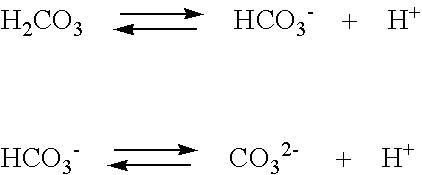Method of treating mine drainage
a mine drainage and water treatment technology, applied in the direction of multi-stage water/sewage treatment, waste water treatment from quaries, separation processes, etc., can solve the problems of limiting the efficiency of water treatment methods, affecting the efficiency of water treatment, and affecting the use of water for irrigation or human purposes, so as to reduce the concentration of transition metals, prevent the formation of unwanted scale, and reduce the potential for scale deposition
- Summary
- Abstract
- Description
- Claims
- Application Information
AI Technical Summary
Benefits of technology
Problems solved by technology
Method used
Image
Examples
example 1
[0062] This example demonstrates the use of the present invention in a typical mine drainage water treatment operation including an aeration tank, settling pond, and discharge point.
[0063] In an abandoned coal mine operation, mine drainage water having a pH of 6.85, alkalinity of 460ppm as CaCO3, calcium hardness of 340ppm as CaCO3, 26.2ppm iron (16.1 ppm as Fe+2) and LSI of −0.2 was fed to an aeration tank. The water was aerated and the water leaving the aeration tank had a pH of 7.10, alkalinity of 540 ppm as CaCO3, calcium hardness of 290 ppm as CaCO3, 19.2 ppm iron (12 ppm as Fe+2) and LSI of 0.0 was treated with lime and pumped uphill to a settling pond. The water, after discharge from the settling pond, but prior to combining with a natural occurring waterway, had a pH of 8.45, alkalinity of 380 ppm as CaCO3, calcium hardness of 210 ppm as CaCO3, 0.4ppm iron (0 ppm as Fe+2) and LSI of +1.1. Fizz tests indicated the presence of scale deposits after discharge from the settling ...
example 2
[0065] This example demonstrates the use of the present invention in a typical mine drainage water treatment operation including an aeration tank, settling pond, and discharge point.
[0066] In an abandoned coal mine operation, mine drainage water having a pH of 6.95, alkalinity of 530 ppm as CaCO3, calcium hardness of 1008 ppm as CaCO3, 111 ppm iron and LSI of +0.4 was fed to an aeration tank. The water was treated with lime, mechanically aerated, and allowed to flow to a settling pond. The water discharged from the pond, prior to combining with a natural occurring waterway, traveled about 400 feet down a spillway, where a sample point was located. The water at the sample point had a pH of 8.27, alkalinity of 360 ppm as CaCO3, calcium hardness of 950 ppm as CaO3, 0.16ppm iron and LSI of +1.5. Fizz tests performed on rocks at the sample point indicated the presence of scale deposition.
[0067] The same mine drainage water was aerated and treated with lime and flowed to the settling po...
example 3
[0069] This example demonstrates the use of the present invention in a typical mine drainage water treatment operation including an aeration tank, settling pond, and discharge point.
[0070] In an abandoned coal mine operation, mine drainage water having a pH of 6.70, alkalinity of 597 ppm as CaCO3, calcium hardness of 402 ppm as CaCO3, 12.2 ppm iron and LSI of −0.1 was fed to an aeration tank, treated with caustic soda to raise the pH and mechanically aerated. An anionic flocculant, KR-0883 available from Kroff Chemical, was added at 1 ppm on an active basis to the aerated water and allowed to flow through a flocculating chamber, followed by a series of settling ponds. Upon exiting the settling ponds, the pH of the clarified water was adjusted to a pH of 7.1 with HCl. The water went through a final polishing pond, then along a rock-laden spillway prior to discharge in a local river. A sampling point with test rocks was established in the spillway approximately one hundred yards from...
PUM
| Property | Measurement | Unit |
|---|---|---|
| pH | aaaaa | aaaaa |
| pH | aaaaa | aaaaa |
| pH | aaaaa | aaaaa |
Abstract
Description
Claims
Application Information
 Login to View More
Login to View More - R&D
- Intellectual Property
- Life Sciences
- Materials
- Tech Scout
- Unparalleled Data Quality
- Higher Quality Content
- 60% Fewer Hallucinations
Browse by: Latest US Patents, China's latest patents, Technical Efficacy Thesaurus, Application Domain, Technology Topic, Popular Technical Reports.
© 2025 PatSnap. All rights reserved.Legal|Privacy policy|Modern Slavery Act Transparency Statement|Sitemap|About US| Contact US: help@patsnap.com

